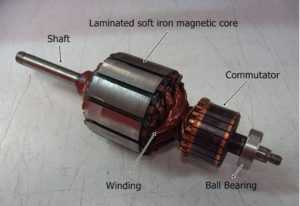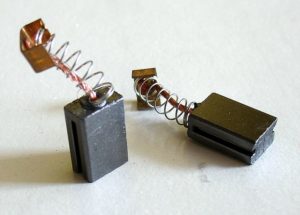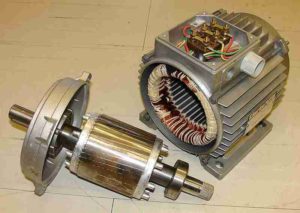14 Electric Motor Components and their Functions Explained
Electric motor components include commutator, brushes, stator, rotor, windings, terminals, bearings, shaft, casing, air gap, pulley drive, yoke, poles, and insulation.
In combination, these components ensure that electricity is converted to mechanic energy through an efficient electromagnetic and electromechanical process.
This article discusses electric motor components and their functions, as follows;
1). Commutator as one of the Electric Motor Components
The commutator is an electric switch, that operates using a rotary mechanism, to control the flow of current in the windings of an electric motor [3].
It is one of the most important electric motor parts, as it determines how effectively electricity will be converted to mechanical energy.
Commutators are often in the form of a ring-shaped metallic conductor, which may be made from copper or any other highly-conductive material. It may be split into two or more segments, each of which are insulated from each other, to make them independent current-flow terminals.
The segments are also usually insulated from other conductive parts of the electric motor, aside the coil (windings). A direct connection generally exists between the commutator and the rotor (or armature windings).
Current reversal, is the key role of the commutator as one of the conductive electric motor parts. It ensures that current which flows into the electric motor, is reversed periodically as it flows through the rotor or armature coils.
The purpose of current-reversal is to produce a continuously rotating, uniform-directional torque. This is usually necessary in DC motors, which is a type of electric motor that depends solely on direct current from a battery.
Current reversal occurs at the end of each 180° turn of the rotor, which is half of a complete revolution. The result of this is a rotary electromagnetic induction effect between the magnetic field produced from the reversing current in the rotor (armature) and the stationary magnetic field from the stator (field windings) or permanent magnet.
This effect leads to electromechanical conversion, whereby rotary motion is produced from the interacting magnetic fields. In the absence of reversal (which is done by the commutator), a DC supply cannot produce a complete revolution through electromechanical conversion.
This is because a direct current will produce a unilateral, unidirectional field that can only produce a half-revolution (180°). Current reversal switches the electromagnetic poles of the field produced by the DC, so that a rotary torque, rather than a unidirectional field motion is produced in the rotor.
There are no other electric motor parts that can substitute for the role of a commutator, in DC motors. Some AC motors also use commutators, but this is necessary only in cases where the alternating current occurs in a phase that opposes the production of electromechanical rotary torque.
Due to the structure of this component, the commutator is also referred to as ‘slip-ring’ or ‘split-ring’.
In order to derive a clear understanding of the role of commutators, they can be considered similar to inverters, in that they carry out reversal, conversion and modification of a DC input, to produce a more usable form of electricity.

2). Brushes as one of the Electric Motor Components
The brush is a primary example of electric motor parts designated solely for current conduction [8].
Brushes are required chiefly because of the need to transfer current from a stationary source, to mobile components.
The rotary source refers to the point(s) of current input, which may be the battery or generator and their adjoining wires, while the mobile components include windings such as the rotor (armature).
Typically, an electric motor is equipped with at least two brushes. These brushes work together with the terminals (current input points) and commutators to ensure that current flows in the desired manner, through the motor.
Brushes are usually made from graphite, copper or any other material that suits the thermodynamic and electrical requirements of the motor.
Essentially, brushes act as a bridge to conduct electricity from the supply source to the rotor. Common problems associated with brushes include frictional wear, and loss of conductivity [9]. These faults can affect the efficiency of other electric motor parts.

3). Stator as one of the Electric Motor Components
Of all electric motor parts, the stator is one of the most important with regards to electromagnetic induction and electromechanical induction.
It derives its name from being stationary [1] and working alongside the rotor.
The key role of the stator, is to create a magnetic field to interact with the electromagnetic field of the rotor nd produce rotary motion. In order to achieve this, it may be designed in the form of a permanent magnet (as in PMDC motors) or as a set of field windings.
Stators may have relatively-complex configurations, especially in complex-technology electric motors. For example, a stator may comprise of a row of magnets enclosed in a single unit, or a core and outer casing.
Where a stator core is present, it may comprise of thin sheets of metal called laminations, whose role is to reduce the rate of electromagnetic and eddy current losses that may occur provided a solid core is used [5].
Laminations are usually composed of ferromagnetic materials like silica steel. They are also usually insulated from each other.
In cases where a coil (electromagnet) is used as stator, it is usually made from copper wire. Stators derive their importance from the essential nature of their role, which determines the overall efficiency and performance of the electric motor.
4). Rotor as one of the Electric Motor Components
The rotor derived its name from the rotary motion which it undergoes in an electric motor.
Essentially, the rotor can be used to assess the performance of all electric motor parts at any given time. This is because it delivers the end-product of electromechanical conversion, which is mechanical energy.
In order to achieve this, rotors must produce an electromagnetic field to interact with the magnetic field produced by the stator [7].
Like the stator, a rotor may occur as a set of windings (armature) or a singular solid component. When windings are involved, they are usually coiled around a solid core, which is composed of laminated ferromagnetic material like silica steel [6].
The windings themselves may comprise of copper material. When current flows through these windings, a dynamic electromagnetic field is generated. This field interacts with the magnetic field from the stator, to produce mechanical energy, through the process of electromechanical conversion.
Mechanical energy from these interactions, as well as reversal of current (in commutated motors) result in continuous rotary motion, of the rotor.
The rotor works closely with other electric motor parts like the stator, brushes, commutator, air gap, bearings and shaft. Shafts are often an extension of the rotor, which help to transfer the mechanical energy produced by electromagnetic induction.

5). Windings
Windings are coiled wires which usually surround a metallic core made from ferromagnetic material like iron or silica steel.
The main role of windings in an electric motor, is to create magnetic fields. These fields may either emanate from a permanent magnet, or from electric current, through the electromagnetic effect.
Another way to describe the role of windings, is for the creation of magnetic poles.
Windings are important as they initiate the magnetic conditions which are required to operate the motor. They also act as inlets for electric current which is needed directly or indirectly by all electric motor parts.
in some cases, permanent magnets or other ferromagnetic materials may be used in place of windings. This substitution can be observed in PMDC and hysteresis motors; among other types.

6). Terminals as one of the Electric Motor Components
Terminals are the supply points for current inflow to the electric motor.
Their role is to supply and transfer AC or DC current from the source (generator, battery) to the electric motor parts (rotor, stator, brushes, commutator) where this current is required.
Terminals may either occur as individual units, or as part of composite block.
7). Bearings as one of the Electric Motor Components
Bearings support the rotor and shaft of an electric motor, allowing them to rotate with minimal resistance.
These electric motor parts (shaft and rotor) are usually adjoined, and play the important role of producing an output from the electromechanical conversion carried out by the motor, in the form of rotary motion.
The presence of bearings limits the effect of friction on the motor, thereby minimizing energy losses. This makes it possible to transfer the mechanical energy from the rotor to the load, with efficiency and effectiveness.
In addition to minimizing friction, bearings support the body or casing of the electric motor. They are usually made from minimal-friction materials like aluminum.
Effectiveness of bearings depends on design, composition, environmental conditions and load.
Components of an electric motor bearing include groove (raceway), balls (bearing spheres), and shields.
To ensure optimal performance, bearings must be lubricated [2] and protected from overloading or excessive pressure.
8). Shaft as one of the Electric Motor Components
The role of a shaft is to connect all rotating electric motor parts to the point of mechanical energy generation.
In most cases, the shaft is in direct contact with the bearings, and serves as a carrier for the rotor, which then transmits mechanical energy to the load.
To achieve its purpose, the shaft is generally designed as a cylindrical, metallic component that can rotate efficiently and with minimal friction, when supported by the bearings.
9). Casing as one of the Electric Motor Components
The casing is an external component whose main role is to protect other electric motor parts like the stator and rotor.
Essentially, the casing acts as a boundary between the internal structure of the electric motor, and the external environment, and mitigates the effect of physicochemical factors like humidity and temperature, on the performance of the motor.
In order to reduce weight and the prospect of rusting and frictional disintegration, the casing may be made of materials like aluminum.
Although they are commonly described to be the same, the casing of an electric motor differs from the yoke or frame, which houses specific components like the bearings, stator or rotor. On the contrary, the casing ideally performs an overall protective function for all components of the motor.
10). Air Gap as one of the Electric Motor Components
Air gap refers to the space that occurs between the electric motor parts that are responsible for electromagnetic induction.
In a typical electric motor, the air gap exists between the rotor and stator [4]. Its main function is to create space to allow for free rotation of the rotor.
The width of the air gap has an inverse effect on the performance of the electric motor. This is because electromagnetic induction must occur effectively between the stator and rotor in order for the motor to be efficient.
An excessively large air space reduces the intensity of the magnetic interaction between the rotor and stator, and therefore reduces the effectiveness of electromagnetic induction. As a result, effort is usually made to minimize the size of the air gap when designing electric motors.
11). Pulley Drive as one of the Electric Motor Components
Also known as the ‘drive pulley’, the pulley drive is needed only in relatively-complex electric motors.
Its role is to transfer mechanic energy (rotary motion) from the rotor to other electric motor parts, or to the external load.
The pulley drive is designed to resemble the gear system of other machines, and includes a circular disc with a grooved circumference through which a belt or cord is wound.
12). Yoke as one of the Electric Motor Components
The yoke is a housing component that protects or conceals specific electric motor parts like the rotor or stator.
It ideally differs from the casing which is a holistic external covering that encloses multiple (or all) components of the electric motor.
However, the names and descriptions of the housing components of electric motors are usually interchanged, so that terms like yoke, frame and casing may be used interchangeably.
13). Poles
Poles may be described as a virtual or ephemeral component of an electric motor. They are the points of strongest magnetic influence which are produced by the magnetic fields of the rotor and stator.
However, poles in an electric motor can be strengthened using pole shoes and pole cores. These are a segment of the stator which are equipped with ferromagnetic windings to supplement the magnetic affinity of the field windings and the stator core.
Due to the presence of poles, a sufficiently energetic magnetic flux is created to produce constant and effective rotation.
14). Insulation as one of the Electric Motor Components
Insulation can be attached to various electric motor parts that are involved in the transfer and/or conversion of electric current. Such parts include the laminated core of the rotor and stator, as well as the windings.
The role of insulation in an electric motor is to minimize electric interference and short-circuitry which can impede the performance of the motor.
Materials used to make the insulation in an electric motor include glass, rubber, resins, mica and enamel.
Conclusion
Electric motor components include;
- Commutator
- Brushes
- Stator
- Rotor
- Windings
- Terminals
- Bearings
- Shaft
- Casing
- Air Gap
- Pulley Drive
- Yoke
- Poles
- Insulation
References
1). Beckett, G. (2018). “Parts of a Motor.” Available at: https://sciencing.com/parts-motor-5426656.html. (Accessed 11 May 2022).
2). Chen, Y.; Jha, S.; Raut, A.; Zhang, W.; Liang, H. (2020). “Performance Characteristics of Lubricants in Electric and Hybrid Vehicles: A Review of Current and Future Needs.” Frontiers in Mechanical Engineering 6:571464. Available at: https://doi.org/10.3389/fmech.2020.571464. (Accessed 11 May 2022).
3). Collins, D. (2016). “What is a commutator?” Available at: https://www.motioncontroltips.com/faq-what-is-the-commutator-in-a-dc-motor/. (Accessed 11 May 2022).
4). Hu, X.; Li, Y.; Luo, L. (2017). “The Influence of Air Gap Thickness between the Stator and Rotor on Nuclear Main Pump.” Energy Procedia 142:259-264. Available at: https://doi.org/10.1016/j.egypro.2017.12.041. (Accessed 11 May 2022).
5). Jara, W.; Lindh, P.; Tapia, J. A.; Petrov, I.; Repo, A.; Pyrhönen, J. (2016). “Rotor Eddy Current Losses Reduction in an Axial Flux Permanent Magnet Machine.” IEEE Transactions on Industrial Electronics 63(8):1-1. Available at: https://doi.org/10.1109/TIE.2016.2547368. (Accessed 11 May 2022).
6). Mozetic, H.; Boff, U.; Luna, W. H. D.; Pfingstag, M. E.; de Martins, R. M.; Dias, M.; Scaheffer, L. (2016). “Development of cores for mini motors from laminated sheets of electric steel ABNT (Brazilian association of technical standards) 35F 420M with thermal treatment.” Journal of Electrical Systems 12(2):357-372. Available at: https://www.researchgate.net/publication/304942671_Development_of_cores_for_mini_motors_from_laminated_sheets_of_electric_steel_ABNT_Brazilian_association_of_technical_standards_35F_420M_with_thermal_treatment. (Accessed 11 May 2022).
7). Nagarajan, P. K.; Isha, T. B. (2016). “Electromagnetic field analysis of 3-Phase induction motor drive under broken rotor bar fault condition using FEM.” 2016 IEEE International Conference on Power Electronics, Drives and Energy Systems (PEDES). Available at: https://doi.org/10.1109/PEDES.2016.7914562. (Accessed 11 May 2022).
8). Wahab, A. A.; Abdullah, N. F.; Rasid, M. A. H. (2019). “Commutator fault detection of brushed DC motor using thermal assessment.” IOP Conference Series Materials Science and Engineering 469(1):012057. Available at: https://doi.org/10.1088/1757-899X/469/1/012057. (Accessed 11 May 2022).
9). Zhao, S.; Ma, H.; Jiang, M.; Li, C.; Liu, Y.; Zhao, X.; Chen, X. (2021). “Study of Carbon Brush and Slip-Ring System Abrasion From Electric Contact Friction Under Special Environments.” IEEE Access PP(99):1-1. Available at: https://doi.org/10.1109/ACCESS.2021.3050098. (Accessed 11 May 2022).